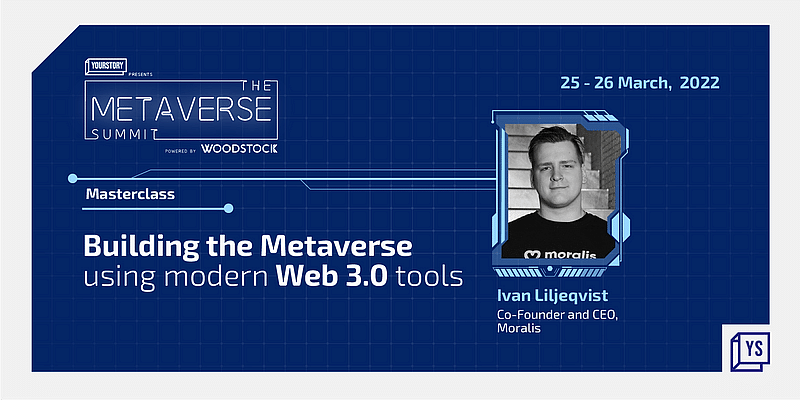Web3 has a very real possibility of becoming the buzzword of 2022 – and it’s easy to see why. Blockchain evangelists are bullish on Web3, a decentralised user-owned internet that could replace Web1.
Instead of accessing the web through services controlled by Big Tech players like Google and Facebook, Web3 would feature new services owned by their users and let us carry our data around and move between sites with one “account” minus the zillion log-ins we see today.
It’s also obvious why analyst Jeremiah Owyang described it as a shift of power to the people, where “the people are in charge of their data, identity, and monetisation”.
Nevertheless, as exciting as its potential may be, Web3 is complicated to grasp in its current form, and Ivan Liljeqvist, the co-founder and CEO at Moralis, a Web3 development platform that provide tools for developers to build Web3 and Metaverse experiences, helped ‘untangle’ Web3 for attendees at The Metaverse Summit.
An international speaker, educator, developer, data scientist and thought leader, Ivan’s Youtube channel ‘Ivan On Tech’ has over 4,50,000 subscribers. In his masterclass, Ivan spoke about building the Metaverse with modern Web3 tools and how Web 3.0 and the Metaverse can complement each other to create powerful and poignant progress.
“There is nothing else that is this big that has been built,” says Ivan as he spoke about how players across the world are waking up to the possibilities of the Metaverse powered by Web3.
“Big Tech and Big Finance is betting on the Metaverse,” he added, talking about Facebook’s Meta pivot, JPMorgan estimating that the Metaverse opportunity is above $1 trillion and Microsoft’s $69 billion deal to buy gaming giant Activision Blizzard,
The Metaverse and the gamification of everything
“The gaming industry is driving the Metaverse revolution. Gaming technologies are going to transition to being not only for games, but also for a host of digital experiences – where we work, where we educate ourselves, or where we perform different tasks – it is going to be all online and immersive,” said Ivan talking about how the gamification of everything was at the core of the Metaverse’s current experiences and its potential for impacting the future of work, learning, and entertainment.
Ivan also spoke about how game and AI developers and allied skills were going to be massively in demand, with the gamification aspect of the Metaverse.
“Game engines that have full support for VR and AR will be at the core of the Metaverse, and we will use the traditional game and graphics stack for it. The trend is clear, enterprise VR is going to be the first one to take off, but consumer VR will follow as well,” he added.
Building the Metaverse with modern Web3 tools
In order to have a sustainable Metaverse future, it needs to be built in tandem with Web3. “At the core of Web3 are different blockchains that include Etherium, Solana Binus, and many others. That’s the base layer,” said Ivan.
Explaining what a blockchain node was, and how it consists of numerous blocks of data, which are stored on nodes that can be compared to small servers, Ivan added, On a blockchain, these nodes are connected and they continuously exchange the newest information on the blockchain with each other. The process of installing and setting up these nodes, however, is quite laborious and time-consuming, and has led to the creation of node providers like Moralis that provide services to other startups or businesses looking to use the blockchain.”
And while connecting to nodes can help businesses get raw data from the blockchain, it is very primitive and cannot tell you what kind of assets your user has. “You also cannot do it by speaking to a node provider alone, instead, you need to use an API. This is where Moralis comes in. We’ve already taken all of the most important data, put it into a database, ensured that it’s clean and ready to use,” he said.
Ivan also explained how Moralis’ Speedy Nodes run on specially crafted distributed infrastructure that ensures peak performance and uptime. “The same infrastructure is used by companies like Netflix and Google to serve billions of requests daily. No syncing time, no waiting – get access to all nodes with just one click,” he added.
Moving from theory to practice
“Our goal is to make Web 3.0 as easy as web 2.0,” said Ivan, recommending viewers to visit Unity Web3, a website that summarises the most important tools for Web3 and the Metaverse.
“So if you’re a developer, just a click takes you to the boilerplate where you could start a project and log in your users by simply scanning a QR code. You can walk around, pick up assets – with all of it connected to the blockchain, letting you read all its data and so on, so forth,” he added.
Ivan also recommends that developers start experimenting right away, while adding that Moralis’ Web3 YouTube Channel was a great place to start.
“On the channel, we show developers how they can easily start building, log users in, working with multiplayers, getting VR headsets going, and so forth,” he said.
Ivan recommended that non-developer founders should bring their developers to the platform as soon as possible so that they can start experimenting.
“At the end of the day, it’s important that you get your first projects going so that you get your first prototypes out in the industry,” he said.
“It’s important to get practical, because a lot of people working with the Metaverse are too theoretical,” he adds.

